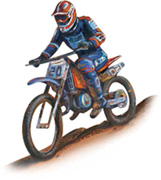
E is for Extreme
An Extreme Sports Alphabet

Written by Brad Herzog and Illustrated by Melanie Rose
Text Copyright 2007 Brad Herzog
Illustration Copyright 2007 Melanie Rose
All rights reserved. No part of this book may be reproduced in any manner
without the express written consent of the publisher, except in the case of brief
excerpts in critical reviews and articles. All inquiries should be addressed to:
Sleeping Bear Press
315 East Eisenhower Parkway, Suite 200
Ann Arbor MI 48108
www.sleepingbearpress.com
Printed and bound in Canada.
10 9 8 7 6 5 4 3 2 1
Library of Congress Cataloging-in-Publication Data
Herzog, Brad.
E is for Extreme : an extreme sports alphabet / written by Brad Herzog;
illustrated by Melanie Rose.
p. cm.
Summary: Extreme sports and its many and varied activities are introduced
from A to Z using poetry, prose, and illustration in this childrens picture
book. Topics include adventure racing, bungee jumping, freestyle skiing, the
Iditarod, and kiteboardingProvided by publisher.
ISBN-13: 978-1-58536-310-0
ISBN-10: 1-58536-310-3
1. Extreme sportsJuvenile literature. I. Rose, Melanie, ill. II. Title.
GV749.7.H47 2007
796.046dc22 2006026986
For anyone who has ever scampered up the dunes, canoed to the lighthouse, paddled a playak, run the Luck of the Draw race, hiked through Pictured Rocks, braved a Big Trip, competed in pushball or speedball or Rindy ball, gone orienteering, windsurfed, skished or played archery golf at Camp Nebagamon in the North Woods of Wisconsin.
BRAD

For Gerry.
MELANIE
A
An adventure race is a nonstop, multisport event in which teams of one to five people travel through some of the most remote and challenging places in the world. Some races take only a few hours, while others last more than a week. The racers move along a series of checkpoints where they can replenish supplies, but they are expected to carry their own gear. Sports featured in adventure races have included running, rappelling, horseback riding, mountain biking, swimming, sea kayaking, whitewater canoeing, even scuba diving.
Many adventure races also require an element of orienteering, which is the ability to navigate using a map and compass in the wilderness. Several raceswith exotic names like Eco-Challenge, Primal Quest, and The Raidhave become world-famous events held in places ranging from Morocco to Madagascar. But not all adventure races take place in remote wilderness. Some races through cities, like the Wild Scallion Race in Chicago, require skills ranging from scootering to stair climbing.
Catch air on a mountain bike. Ascend a steep rock face. Go all around the world. A is an Adventure race.

B
Bronc riding is one of the most exciting events in rodeo (a Spanish word meaning roundup). Imagine sitting on an untamed bronco in a small enclosure known as a bucking chute. With one hand, you grip a special rigging or rope attached to the wild horse. You nod your head, the gate of the chute opens, and the bronco charges into the arena, attempting to throw you off in any way possible. You try to stay atop the animal for eight seconds without falling. Judges award points based on the performance of both the rider and the animal. A perfect score is 100 points. If the rider is bucked off or touches the animal or any of his equipment with his free hand, he receives no score.
Bull riding is even more dangerous, as brave cowboys climb atop angry, one-ton beasts with sharp horns. Often the bulls become as well-known as the cowboys. From 1984 through 1987 a famous bull named Red Rock bucked off everyone who tried to ride him309 attempts altogether!
B is for a Bucking Bronco or a big, bad bull. Eight seconds seems like forever to make a ride in full.

C
Every year a handful of courageous athletes compete in a remarkable ultracycling competition called the Race Across America(RAAM). It is a 3,052-mile, single-stage bike race from San Diego, California, to Atlantic City, New Jerseya coast-to-coast journey through heat, humidity, hail, 50-mph headwinds, and combined climbs totaling some 110,000 feet. Each rider (or team of riders) is followed by a crew in a van that offers nutritional, medical, and mechanical aid. But the race still amounts to a test of mental and physical endurance.
Traditionally, the top competitors have ridden some 350 miles per day while averaging barely 90 minutes of sleep every 24 hours. Because the lack of sleep can be so dangerous (two riders have been struck by passing trucks), in 2006 race officials added a mandatory rest period each day for cyclists who wish to win prize money. But some riders still choose to compete in the Nonstop Record Category anyway. Finishing the race is their reward.
C is for Cycling coast-to-coast without a moment to losea chase across the continent, hardly a pleasure cruise.

D
Drag racing is loud, dangerous, and very fast. It usually involves two cars starting from a dead stop and racing over a short, straight course to see who crosses the finish line first. The winner moves on to the next heat until there is only one undefeated racer left. The most common distance is a quarter-mile course, although the drag strip extends beyond the finish line to allow cars to slow down. Drivers dont have to make any turns, but they must be able to react quickly, shift gears properly, and keep the car on course. There is no time to recover from mistakes.
The National Hot Rod Association (NHRA) oversees most drag racing events in North America and offers dozens of racing divisions, including a category for aspiring young racersJunior Dragster. The fastest cars are Top Fuel dragsters, which look almost like rockets on wheels and can reach speeds of over 300 miles per hour and cover a quarter-mile distance in less than five seconds!
A day at the Drag races thats our letter D . At 300 miles per hour theyre the fastest cars youll see.

E
When mountaineer George Mallory was asked in 1923 why he wanted to climb Mount Everest, the worlds highest peak at29,035 feet above sea level, he answered, Because it is there. Climbing Everest is extremely difficult and dangerous. Mallory was lost on the mountain one year after making his statement, and it wasnt until May 29, 1953 that Sir Edmund Hillary and Tenzing Norgay became the first men to conquer Everest. To date, about 1,000 people have managed the feat. The youngest was 15 years old!
Mountaineers, also known as alpinists, brave many perils (including falling rocks and ice, avalanches, deep crevasses, and severe weather). So they must select the best route up a mountain at the proper time of year. To avoid altitude sickness, climbers get accustomed to the lack of oxygen at loftier heights by sleeping at gradually higher base camps, sometimes even over the course of several weeks. Most mountaineers use bottled oxygen when climbing the highest mountains, like Everest.
Next page




















